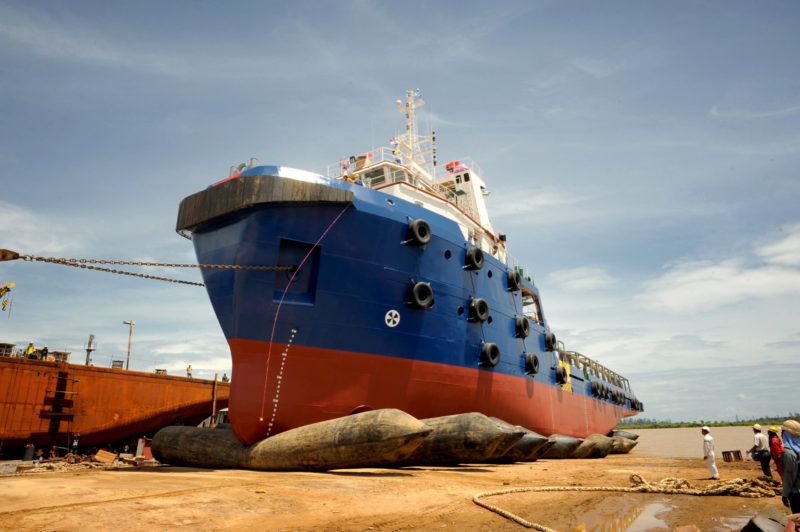The American Bureau of Shipping recently collaborated with Google Cloud and software engineers SoftServe to use artificial intelligence (AI) models to detect levels of corrosion and marine coatings breakdowns on brown- and bluewater vessels.
The pilot project is aimed at developing image recognition software tools that can examine early signs of degradation in hull structures, to avoid unsafe working conditions, unscheduled maintenance and resulting operational downtime.
The effort demonstrated how AI can support early detection of structural anomalies that are usually found through traditional, visual inspections. The project was focused on corrosion and coatings failures, but ABS engineers believe the new tools could also be used to detect stress fractures and larger hull deformations.
These AI techniques — in tandem with advanced data algorithms — could be used to analyze images over time to understand the trends in corrosion and asset fatigue that would support a transition to more efficient class and maintenance regimes for everything from workboats to offshore structures.
“Digital innovation in AI will change how surveys and maintenance strategies are executed, driving more condition-based approaches to class and maintenance,” said Christopher Wiernicki, ABS chairman, president and CEO, in a statement announcing the project findings.
“We are building a future in which digital tools can remotely assess the condition of a ship or offshore unit, and automatically detect and measure coating breakdown and other structural issues, improving safety and reliability,” said Wiernicki.
Using machine learning, the tools, will help to improve the efficiency, accuracy and objectivity of visual inspections. The condition of marine coatings, for example, is rated by subjective assessments of the percentage of areas with failed coatings and/or rusty surfaces.
An image-recognition tool that identifies the breakdown, calculates the area and offers consistent ratings would benefit the industry in that it would offer more objective and consistent results, and a sounder basis for operational and investment decisions.
The inherent value of image-recognition tools increases for projects in which remote-inspection technologies such as drones, remotely operated underwater vehicles or crawlers are used to collect data (images, videos, etc.). Having to review hours of video footage is an arduous task. The AI-based tools could screen the data and select the key datasets for review by inspectors, improving the efficiency and accuracy of the whole undertaking.
The pilot project was designed to study the feasibility of developing tools that possess machine-learning capabilities to reduce the downtime of marine assets. Beyond proving feasibility, the goals are to better understand the challenges of using AI-driven inspections, to develop an efficient labelling strategy, and to compare and contrast machine-learning algorithms and models.
Image-recognition programs that use machine learning are presently deployed in high-profile commercial areas such as medical imagery, autonomous cars and facial-recognition applications in the security sector.
While AI-driven image recognition is considered proven technology in other industries, the marine environment has unique characteristics and challenges to overcome before it can be used to help predict asset or component failure.
In non-marine fields, the objects that the technology is being asked to analyze have well-defined characteristics in terms of shape, color, etc. For marine applications, the anomalies that need to be detected and analyzed are likely to be more random in shape, pattern and color, which will make accurate assessments more complex.
Marine assets complex designs, potential inspection impairments such as mud or bio-fouling, different types of coatings and inadequate lighting will add to the challenge. When those issues are resolved, however, the potential benefits from AI-driven inspections on brownwater assets could include:
Safety: They will reduce the demand for physical attendance by inspector/surveyor, particularly in high-risk locations such as in enclosed spaces or at height.
Accuracy: They have the potential to deliver reliable, consistent assessments based on objective data analytics, leveraging machine learning.
Efficiency: They can speed up the evaluation process, potentially reducing the impact of periodic inspections on operations.
With owners and operators under constant pressure to look for safe ways to reduce operating expenses by finding more efficient ways to maintain their assets, a growing number of strategic partnerships with non-marine companies are being struck to explore the potential of innovative digital solutions, including those that offer new approaches to maintenance and class.
“By combining our deep domain experience in offshore and marine structures with Google Cloud’s extensive knowledge of AI applications and SoftServe’s development capabilities, we were able to take this idea from concept to reality,” said Kashif Mahmood, ABS’s deputy chief digital officer.




